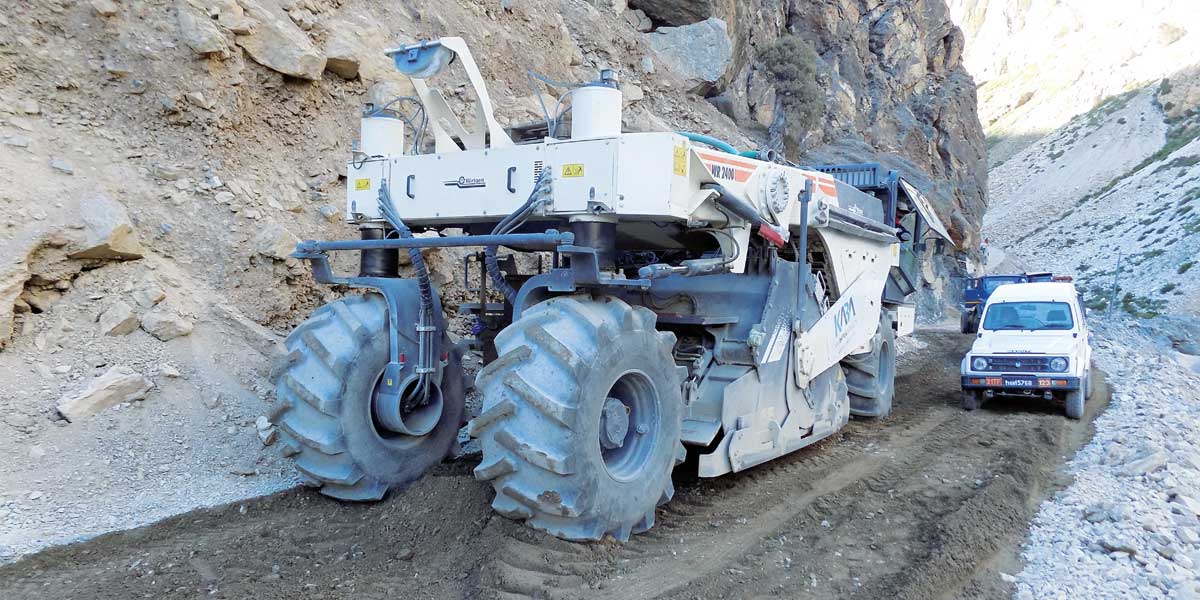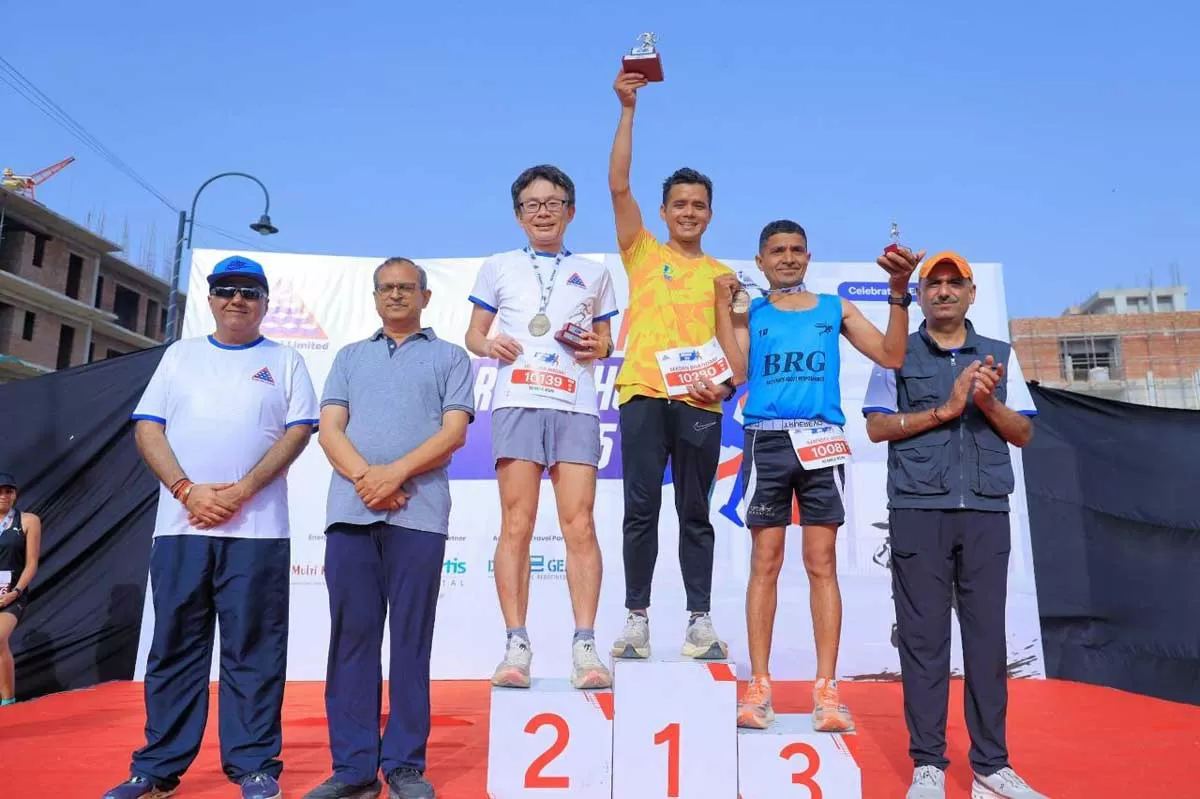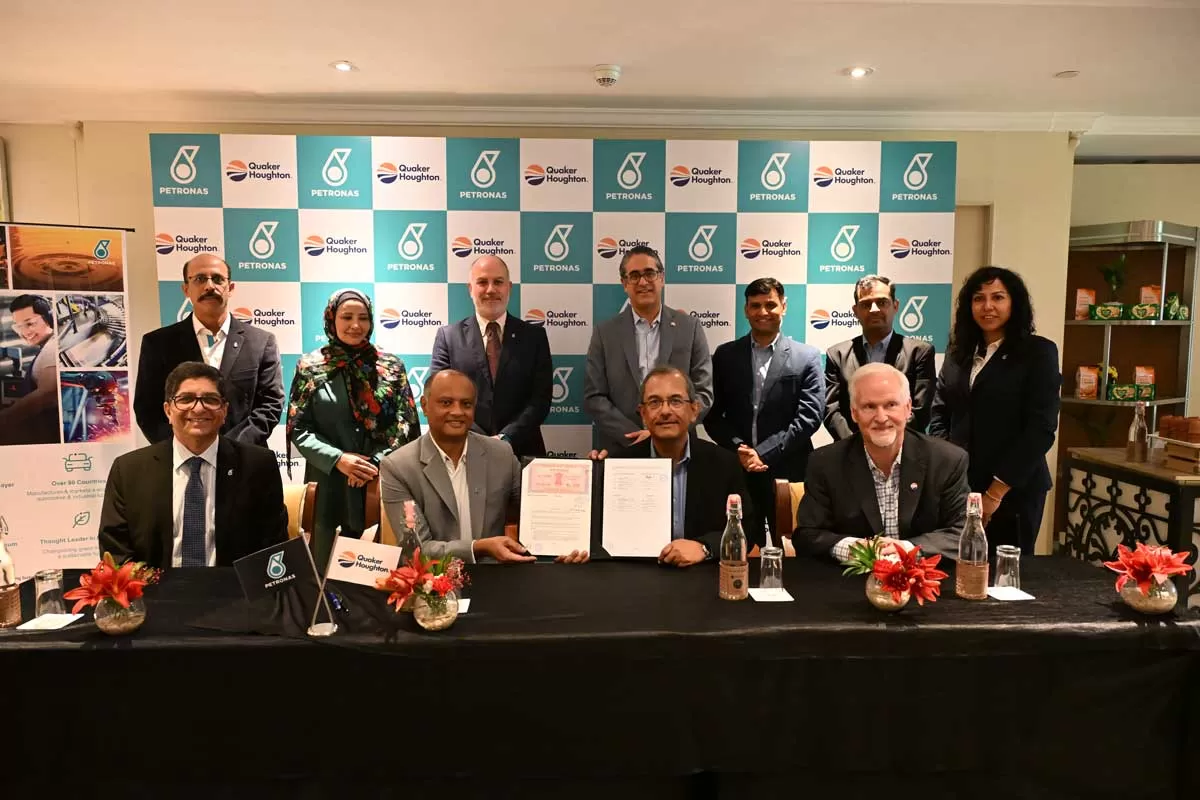Over the past few years, road construction technology and associated processes have received a major impetus from the government and a lot of modernisation has taken place in this field, with new technologies being introduced to improve both, the quality and speed of construction. In keeping with the times, BRO has also taken key initiatives to keep itself abreast with these new methods, and despite the remote and inaccessible areas where the BRO is deployed, has been successful in implementing some of the new construction technologies across various projects.
Cementitious sub-base/base courses
Construction of 240 km of roads is being undertaken in Ladakh, Uttarakhand, Sikkim and Arunachal Pradesh using this technology.
Geo cells
In certain stretches of BRO roads like Hapoli-Sarli-Huri road in Arunachal Pradesh, geo cells are being utilised to enhance the speed of construction and give stability of the formation.
Non-frost susceptible sub-base
High altitude areas are primarily subjected to heavy snowfall and frost action which requires special consideration for design and construction of roads in such snow bound areas. The soil on Chisumle-Demchok road at an altitude of above 19,000 feet with sub-zero temperatures in winters is extremely prone to frost heaving. In order to ensure that the road remains durable and retains its smooth driveability throughout its design life, it had to be ensured that the pavement is free of the effects of heaving and thawing. Coarse aggregate with all particles about the same size is best suited for this purpose as it has pore size that are too open and porous to promote capillary flow. Accordingly, layer composition here was chosen as NFSSB (larger particles with no sand) rather than GSB which is normally used at lower altitudes. This has prevented the uneven settlement on Chisumle-Demchok road due to frost heaving and freeze thawing.
Slope stabilisation to mitigate landslides
Slope stabilisation is being carried out using various suitable methods throughout the projects of BRO to alleviate the triggering of landslides causing severe damage to the roads.
Avalanche protection structures
These structures reduce the hazard that the avalanches pose to human life activities and property. The inhabitants of mountainous areas in snow zone have always been affected by the risk of avalanches and the need to live alongside this threat has led to attempts to mitigate the risk by constructing intricate systems of artificial structures. The following snow protection structures have been constructed by BRO on approach road to south portal of Atal Tunnel.
Snow Erdox: The Snow Erdox structures are protection measures that are placed in the zones of avalanche initiation and stabilise the snowpack. These limit the volume of snow that can be mobilised, reducing the overall avalanche hazard risk. The snow erdox supporting structure is a modular unit with a single anchorage element. It features a cruciform facing panel structure made with steel beams which are hot dip zinc coated and suitably shaped to enable rapid jointing.
Snow Galleries: Snow Galleries are direct defence measures for roads or highways in the middle zone of avalanches. They protect roads against the effect of avalanches by bypassing them. A snow shed or avalanche gallery is a type of rigid snow-supporting structure for avalanche control to maintain passage in areas where snow removal becomes almost impossible. They can be made of steel, prestressed concrete frames, or timber. These structures can be fully enclosed, like an artificial tunnel, or consist of lattice like elements. They are typically of robust construction considering the environment they must survive in.
Towards Aatmanirbhar Bharat
BRO has taken an initiative towards Aatmanirbhar Bharat by launching a Cl-70R single lane modular bridge of span 190 feet on Dharasu-Gangotri road in Uttarakhand and 140 feet span double lane modular bridge on Flag Hill-Dokala road in Sikkim which is first-of-its-kind; in a joint venture with Garden Reach Shipbuilders & Engineers (GRSE) Ltd at one-third of the cost of imported bridge. These bridges are reusable and portable and launched within two months on permanent abutments. BRO and GRSE also signed a Memorandum of Understanding (MoU) on 15 March 2022 for two years for fabrication, supply, erection, and launching of 27 double lane galvanised modular bridges of 7.5 meters carriageway with IRC Load Class 70. One of the most important and critical advantages of the MoU will be the time factor as these bridges can be launched within 45 days of handing over of the site by the units. This will certainly be a game-changer in road infrastructure development in the country.
Runways with sub-surface drainage system
BRO is constructing two runways, one each in Barrackpore and Bagdogra in West Bengal. In the runway at Barrackpore, a state-of-the-art sub-surface drainage system is being constructed. There are not many runways across the country with such a comprehensive sub-surface drainage system and the BRO can act as a repository of knowledge to impart training on this aspect of runway construction.
Plastic-coated aggregates in bituminous surfacing
As an initiative to reuse plastic waste, BRO has carried out trials to extensively use this technology in bituminous road construction not only in India, but also in Bhutan. The technology has been successfully used in the following:
Resurfacing of 4.5 km on Phuentsholing-Thimphu road under Project Dantak in Bhutan.
2.5 km resurfacing on Balipara-Charduar-Tawang road under Project Vartak.
1 km resurfacing on Roing-Koronu-Paya road under Project Udayak in Arunachal Pradesh.
Resurfacing of 5.22 km on Hnathial-Sangau-Saiha road under Project Pushpak in Mizoram.
2 km resurfacing on Hapoli-Sarli-Huri road under Project Arunank in Arunachal Pradesh.
Resurfacing on Ramban-Gul road under Project Beacon in UT of J&K.
5 km resurfacing on Along-Kayling road under Project Brahmank in Arunachal Pradesh.
M-50 inter locking concrete blocks
Inter locking concrete blocks (ILCBs) have been used in BRO where heavy snowfall takes place and snow clearance operations by tracked dozers leads to damages on bituminous layers. This concept of usage of ILCB at high altitude will give higher dividends in the future. The periodic damage to roads in high altitude areas due to snow clearance operations results in disruption of sustained traffic as well as recurring exponential road maintenance cost. In addition, the wear and tear of equipment/vehicles due to damaged roads resulting from snow clearance operations in these areas, adds up to additional cost for maintenance of vehicles as well as riding discomfort. Use of ILCBs will also help in smooth and sustainable riding surface for faster induction of troops, tourists and equipment. The technology will enhance the speed of construction in high altitude roads and dependence of adequate working season for construction of roads will diminish. Overall there will be a substantial reduction in the overall cost on adoption of this technology.
Precast cut & fit technology
BRO worksites are located alongside the most difficult and harsh terrains of the world. These areas typically have very limited working season and completion of road projects in a time bound manner, therefore becomes a huge challenge for BRO. In order to overcome these challenges and enhance the pace of construction of the road, BRO has started incorporating cut and fit technique in road construction. The basic idea of cut and fit construction is to precast all elements of the road in a casting yard, under ideal quality environment while the formation cutting of road is done as a concurrent activity. With this technique, sequential construction is replaced with parallel construction activity to shorten the overall project duration.
BRO has executed a pilot project on Along-Yingkiong road in Arunachal Pradesh with all the precast elements i.e., protective structures, culverts, drains and pavements. Similarly, BRO has also adopted construction of pre-cast box culverts in Ladakh, which has been found to be extremely useful in speeding up construction and averting/reducing disruptions to traffic.
Use of steel slag
BRO has undertaken construction of a pilot road stretch in Arunachal Pradesh using steel slag which can withstand heavy rains and adverse climatic conditions. In this regard, BRO has constructed 1 km stretch of Joram-Koloriang road in Arunachal Pradesh using steel slag in technical consultation with CRRI and steel slag from Tata Steel. The use of processed steel slag in road construction is also expected to reduce greenhouse gas emissions and carbon footprint in road construction activities and is in line with India’s commitment to the United Nation’s sustainable development goal to build resilient infrastructure through inclusive and sustainable industrialisation and green technologies. On successful trials of this technology, the BRO will work out a long-term logistic arrangement for construction of steel slag roads in strategic areas. The project has received accolades from all quarters including the office of the Hon’ble Prime Minister.
White topping technology
White topping is a portland cement concrete (PCC) overlay that is constructed on top of an existing bituminous road. This overlay acts as a long-term alternative for the rehabilitation or structural strengthening of roads. A pilot project of white topping for rehabilitation of pavement has been undertaken by BRO on Tuting-Bona road in Arunachal Pradesh which experiences heavy rainfall.
Carbon neutral habitats
BRO has taken the initiative as a pilot project at various locations in Eastern and Western Ladakh. These habitats entail decentralised energy production mainly from renewable energy sources coupled with energy efficient buildings, optimised water cycle coupled with recycling wastewater and waste management. This is achieved by taking into account the orientation and shape of buildings, natural ventilation, trombe wall as a thermal mass, insulation envelope, layout of the habitats and well oriented pathways to optimally utilise natural resources. Based on the terrain in Ladakh, three models of habitats have been designed:
Model-1: Semi-permanent integrated insulated habitats.
Model-2: Container-based & transportable integrated insulated mobile habitats.
Model-3: Heated and insulated tents for short-duration and transportable habitats.
The aim is to provide dignified and suitable habitats with better health parameters due to lower risk of cold injuries and better hygiene and sanitation to the labourers in Ladakh resulting in greater productivity and work satisfaction. By using renewable sources of energy, BRO aims to reduce dependency on fossil fuels for heating and lighting purposes and reduce environmental and water contamination by using hygienic waste disposal system.
Energy efficient habitats in Ladakh
BRO has taken an initiative to construct energy-efficient accommodation for BRO personnel living in extremely cold climatic conditions as per Energy Conservation Building Code (ECBC) and Eco-Niwas Samhita 2018 for Residential buildings. The overall layout has been done so as to achieve a climate-responsive and thermally efficient building and its design has been vetted by IIT-Roorkee. This will result in a reduction in energy required for heating and lighting by 60 per cent, leading to savings to
the state.
3D printed buildings
To recognise the relentless and untiring efforts of the BRO Karmyogis and to showcase the glorious history and key achievements of this organisation, BRO has planned to construct a museum dedicated to BRO at Leh. The BRO museum will be constructed using 3D printing technology and this building will be the highest 3D printed building in the world. The museum will highlight key projects of national importance executed by BRO and will bring out the challenges and technological innovations used in overcoming the same. The Museum will also pay homage to the BRO Karmyogis who have laid down their lives in the service of the nation. Along similar lines, BRO has also planned to upgrade its air despatch sub-unit located at Chandigarh using 3D printing technology and this complex will be the world’s largest 3D printed technology community habitat.
NCNC trials of sensor-based route guidance system
Earlier, during snow clearance over high mountain passes, difficulties and challenges were faced by BRO in estimating the correct road alignment due to heavy snow accumulation, resulting in major losses of men and equipment. Operator’s past experience and several hit and trial methods were used to ascertain the
actual alignment.
To overcome this, BRO is conducting several NCNC trials at Zojila pass, using sensor-based route guidance system, in which GPS server fed with road alignment data is attached to snow clearance equipment to obtain precise centre line of the road. This will provide the operators with enhanced safety while undertaking this extremely risky snow clearance task.
Super long front (SLF) excavators
BRO with its concerted modernisation drive has inducted 12 super long front (SLF) 65 tonne excavators with 23.5 m boom, one of its kind in the country and has been specially designed and manufactured for BRO. The equipment will help BRO to address all defence preparedness requirements on western front.
As an organisation, it shall be BRO’s constant endeavour to adopt new and innovative technologies in the high altitude, remote, inaccessible and permafrost regions, where BRO is deployed to construct the best quality roads in the shortest possible timeframe to connect the farthest and most remote regions of the mainland with a singular aim of ushering prosperity to these regions.
(Contributed by: Border Roads Organisation)


















